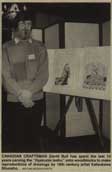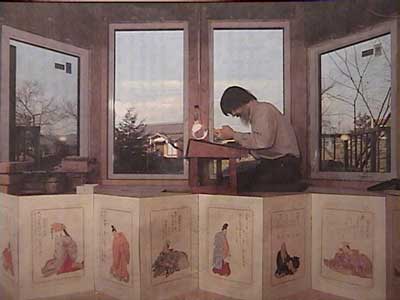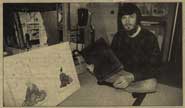In My Viewfinder - David Bull, Woodblock Printmaker
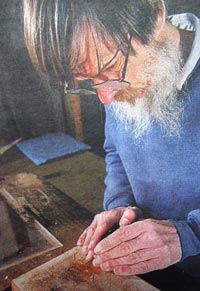 When I arrive at David Bull's home in Ome in Tokyo's western suburb on a cold but sunny morning in late March, he is checking a huge delivery of kiri wood boxes from China. But this time he is not quite satisfied ...
When I arrive at David Bull's home in Ome in Tokyo's western suburb on a cold but sunny morning in late March, he is checking a huge delivery of kiri wood boxes from China. But this time he is not quite satisfied ...
"The finish is not as nice as if a Japanese craftsman had done it," he says. "But on the other hand, it costs only a fraction of the same thing handmade in Japan."
These boxes will carry Bull's exquisite reproductions in scroll form of an ukiyo-e painting by Kaigetsudo Ando, who worked in Edo in the early 18th century. In his studio he shows me this colorful woodblock print, which is carefully mounted on a silk scroll.
"This one image took me one full year to make," Bull says. "So far this is my biggest accomplishment."
Not only for the time it needed, but also it marks a step up in sheer size from his usual smaller format woodblock prints, which he has been making for more than 20 years. His woodblock print series are made in editions of about 200, and are collected by Japanese and overseas clients.
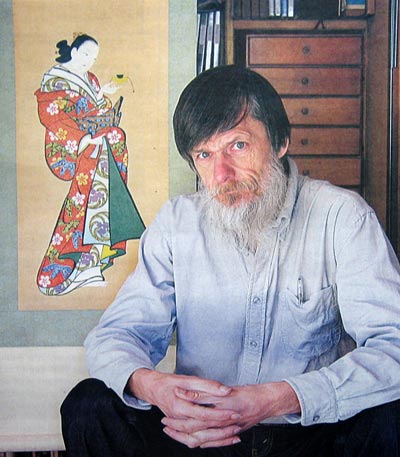
In 1998, he completed his Hyakunin Isshu series, a set of prints depicting poets of ancient Japan. It took him 10 years.
Interestingly, in Japan, woodblock prints are not highly regarded today - unlike calligraphy, pottery, ikebana, or haiku, Bull explains. So how did he get interested in the world of moku hanga?
"Thirty years ago, I lived in Toronto, Canada," Bull recalls, "and there was a boom in Japanese restaurants. I liked the light, fresh food there, and gradually became interested in Japanese culture as well."
One day a local gallery was showing Japanese woodblock prints, and he was intrigued, and became fascinated by them.
He was very curious about how the prints were made, and loved the colors and texture of the works.
"A seed for my future life was planted right there in that gallery," says Bull. Then, on a train from Toronto to Vancouver, he met a Japanese woman, fell in love and in 1986, moved to Japan with her.
"I originally worked as an English teacher and studied woodblock printing by myself," he says. "My teachers were the long-gone workers from 100 years ago, and I had to learn everything from scratch - the reproduction of the image, the carving, the printing, the selling."
In older times, Bull continues, "designing the print, carving it, printing it, and publishing were all done by different people. Everybody involved was the top in his field, and that is why the superb craftsmanship of these old prints never again can be reproduced."
Bull jokes that, "I am maybe one of the best carvers alive today, but certainly not the best printer!" Nevertheless he plans to take the ultimate step, to design the images for his next print series "My Solitudes" as well - a personal challenge he very much welcomes.
This new project will consist of prints of three places (a riverbank, a forest, a sea coast) during the four seasons of the year. These woodblock prints will be published in editions of 12 fine-printed and bound books, featuring stories of his experiences in Mother Nature as well.
"It is incredible," he says. "There are these absolutely quiet remote places right in Tokyo where you don't meet a soul and the hectic city life seems far away. Sitting quietly in front of my tent, I am never bored.
"So much is happening there: a hawk catches a fish only meters away, birds are singing, insects are crawling all over the place, and at night, the many different sounds of the river sound like one fantastic orchestra."
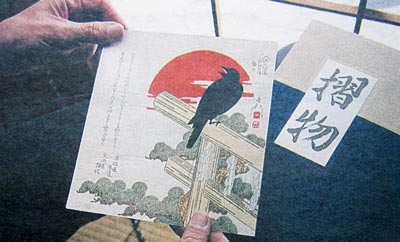
TV Listings
The 'Woodblock Shimbun' has a full selection of TV programs on file. Videos available include some of David's news appearances, complete feature programs, and some short documentaries on his work. The files are in QuickTime format, and can be easily viewed with your browser.
Program listings are on the Index page ... ![]()
Woodblock Man Carves Niche
Woodblock carver David Bull refuses to be called an 'artist' or 'sensei'. "I'm just the guy who carves a piece of wood," Bull said. "All I do is copy what the real artists did." Since 1989, the Canadian university dropout who once played the flute on the streets of London has spent many hours bent over his woodblocks, nose and beard almost touching the surface, as he carved toward a self-appointed goal: the recreation of 18th century ukiyo-e artist Katsukawa Shunsho's 'Hyakunin Isshu: Poems from One Hundred Poets' series. (1999)
Full Story. ![]()
Woodblock craftsman combines old, new
Day after day, David Bull sits in his workroom almost all day long using his energy to make hanga or woodblock prints. His workroom, housed in his four-story house standing on the side of a riverbank in Ome, Tokyo, has yet to be completed because he is building the room himself by taking time from his busy production schedule. (2004)
Full Story. ![]()
Japanese Art with a Canadian Touch
A British-born artist from Canada is holding an exhibition of his 60 works of ukiyoe woodblock prints, part of his 10-year project to carve and print the Hyakunin Isshu poem collection. (1998)
Full Story. ![]()


